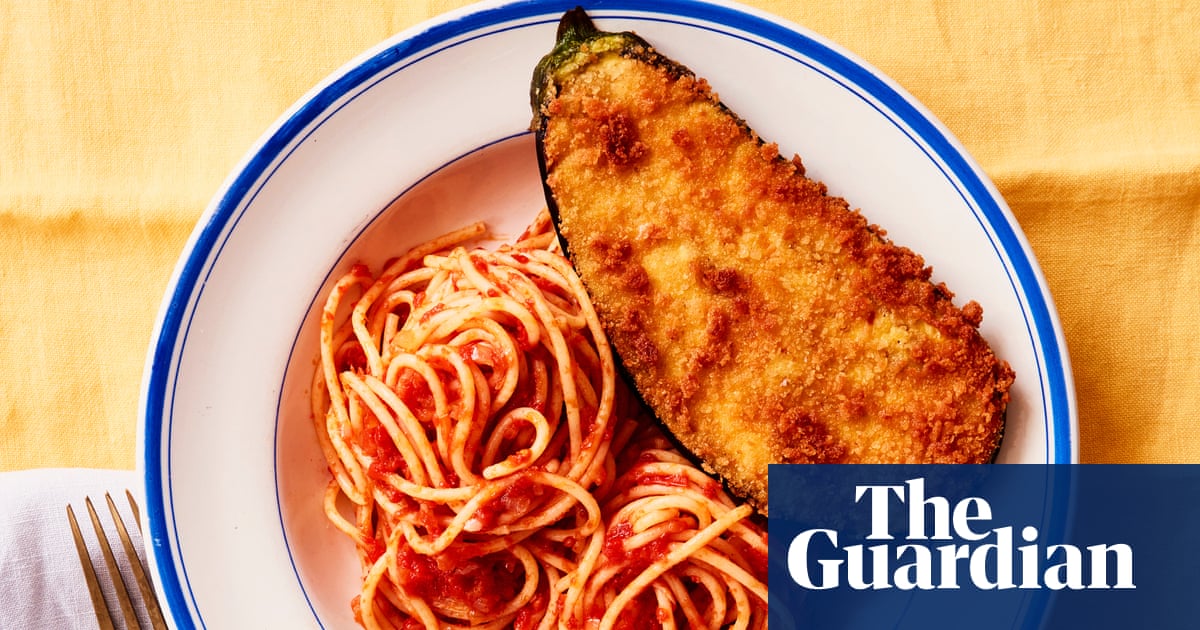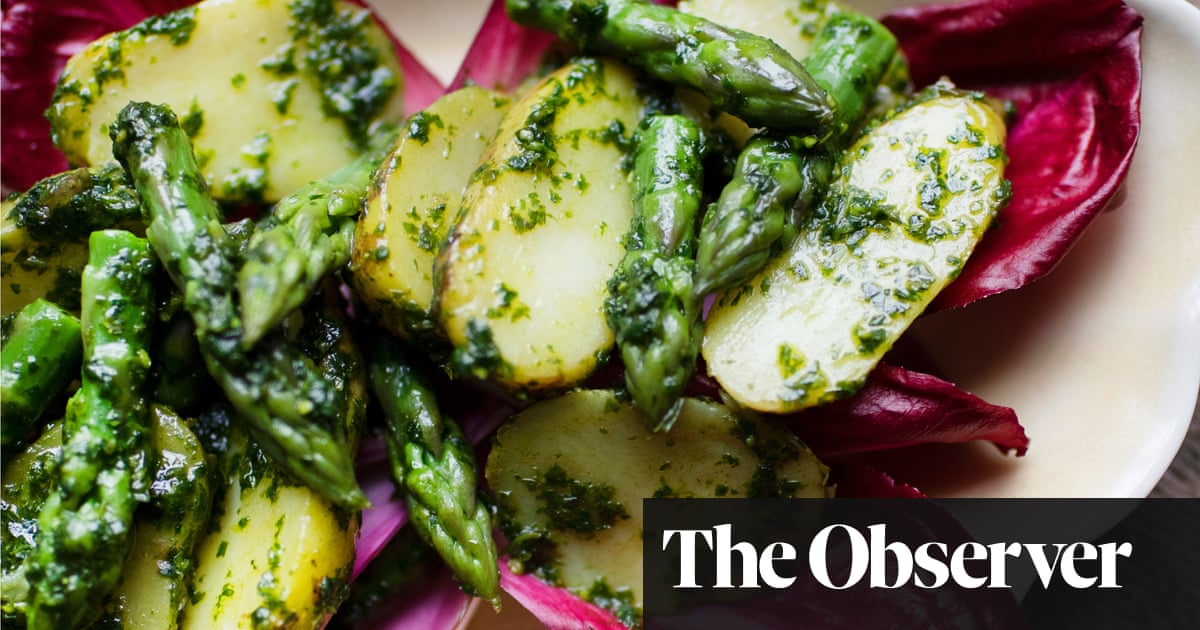
Asma Khan’s prawns with kale
This dish is inspired by the red spinach dish of Bengal. It uses kale as the texture is closest to the hardy red spinach we have in Kolkata. I try to substitute Indian vegetables with local British alternatives where possible to reduce the carbon footprint without compromising the soul of the dish.
Serves 6-8
raw tiger prawns 750g, shelled and de-veined
ground turmeric ½ tsp
salt 1 tsp
vegetable oil 5 tbsp
dried red chillies 4
onion 1 large, finely chopped
garlic 4 cloves, finely chopped
fresh ginger 1 x 4cm piece, grated
tomatoes 2, cut into small pieces
chilli powder 1 tsp
kale 900g, finely sliced (it should be like cabbage sliced for coleslaw)
Place the prawns in a bowl, sprinkle over half the turmeric and salt, rub well on both sides of the prawns and leave for 10 minutes.
In a deep frying pan, heat the oil over a high heat. Gently squeeze the marinating prawns to remove any excess liquid. In Bengal, turmeric and salt are commonly added to seafood – the salt is used to remove excessive water. Add the prawns to the pan and flash-fry for just a few seconds. The prawns should only briefly touch the pan. They will be cooked again. The aim is to seal the prawns, they should curl up while you fry them. Using a slotted spoon, remove the prawns from the pan, place on a plate and set aside.
Using the same pan, add the dried red chillies followed by the onion, garlic and ginger, and the remaining turmeric and salt. Fry over a medium-high heat for a few minutes, or until the raw smell of the garlic and turmeric has disappeared. Add the tomatoes and continue to cook on high. Return the prawns to the pan together with the chilli powder and kale, and stir over medium-high heat. Taste for seasoning. The dish should not have a lot of moisture, and it goes well with rice.
Gobi tamatar
Usually combined with other vegetables, the cauliflower in this recipe gets to shine on its own in a thick tomato gravy garnished with green chillies. Goes best with any kind of Indian bread.
Serves 6-8
vegetable oil 8 tbsp
cauliflower 1kg, trimmed and cut into 5cm florets
bay leaves 2
cassia bark stick 2cm
green cardamom pods 2
clove 1
onions 3 large, thinly sliced into ½ moons
garlic paste 2 tbsp
fresh ginger paste 3 tbsp
ground coriander 1 tbsp
chilli powder 1 tsp
tomato puree 200g
warm water 300ml
salt 2 tsp
sugar 1 tsp
green chillies sliced, to serve
coriander to serve
In a heavy-based pan that has a lid, add 6 tablespoons of the oil over a medium-high heat. Fry the cauliflower florets in small batches and use a slotted spoon to remove them. The aim is to get the florets tinged with brown, not to cook them. They will be cooked in the tomato sauce later. Once all the cauliflower is done, add the remaining 2 tablespoons of oil to the pan. Warm to a medium-high heat, then add the bay leaves, cassia bark, cardamom and clove, and stir for a few seconds. It is important not to burn the spices. If any of the spices burn, remove them and start again. The end tip of the clove will start to swell and change to a pale tinge in the heat. Look out for this, then add the onions and cook, stirring to prevent them from burning and sticking to the pan.
When the onions have started to brown to a caramel colour, add the garlic and ginger pastes. Cook for a minute or till you can no longer smell the raw garlic. To prevent the onion and garlic mix from sticking, spray in some cold water. Do not add a lot as you do not want to stew the mixture. Add the ground coriander and chilli powder, and stir for a minute to make sure the spices are cooked through. If the mixture sticks, add another splash of water.
Mix the tomato puree with the warm water. Add the salt and sugar to the tomato paste and pour into the pan. Increase the heat, bringing the contents to a boil, then reduce the heat to a low rolling boil and stir to ensure the spices do not stick.
As the moisture evaporates in the pan and you can see oil coming to the edges, add the cauliflower. Make sure all the pieces are covered with the masala paste. Raise the heat to high till the sauce is boiling, then cover and simmer for 2 minutes. Uncover and cook on high heat till the sauce clings on to the cauliflower.
If you make this dish in advance, reheat over a low heat. Garnish with chillies and coriander and serve.
Asma Khan is chef-owner of Darjeeling Express, London WC2
Sally Clarke’s beetroot and dill-marinated salmon with mustard sauce
Ask the fishmonger to cut the fillets for you from the head end as these will be thicker. However if you have to use the tail end, the marinade will work much faster and will only need 1½ days to cure. It always seems such a waste to throw the marinade ingredients away, but it must be. The salmon skin, however, which will remain after slicing, could be cut into strips then fried in vegetable or sesame oil to use as a garnish for the dish, or as a snack beforehand, simply sprinkled with salt.
Serves 4-6, depending on generosity
beetroot 1 medium, washed and peeled
salmon fillets 2, roughly 110g each, of equal size and depth
sea salt flakes 25g
sugar 2 rounded tsp, demerara, soft brown or caster
black peppercorns 1 rounded tsp, very roughly ground
dill ½ bunch, chopped medium fine, including stalks
For the dressing
dijon mustard 1 tbsp
honey 1 tbsp
champagne vinegar 2 tbsp, or white wine vinegar
sea salt flakes and freshly ground pepper to taste
To serve
landcress, watercress, or other salad leaves
cooked baby candy beetroot a few, peeled and cut into small wedges. lime
dill sprigs
rye bread
First prepare the marinade. Grate the raw beetroot into a bowl, add the salt, sugar, pepper and chopped dill and mix thoroughly together.
Using a firm set of tweezers pull the stray pin bones from the fillets (or ask your fishmonger to do this). Lay the fillets side by side, skin side down on a sheet of clingfilm, biodegradable if possible. Pile the beetroot mix on top of one fillet and press it gently but firmly, so that it covers the flesh entirely. Place the second piece over the top, skin side up, making a “sandwich”. Wrap the salmon tightly together in the clingfilm, then wrap again in parchment paper or foil.
Place on a deep plate, put a weight (such as a bag of flour or beans) on top of the fish to allow a gentle pressure while the salmon “cures” for 3 days in the fridge. Turn the fish over every 12 hours, replacing the weight on top each time.
After 3 days remove the salmon from the fridge and unwrap carefully on a clean chopping board. Open the “sandwich” and scrape away and discard almost all of the beetroot marinade (a little remaining is fine).
Using a very sharp long bladed knife, thinly slice the salmon vertically towards the skin, and lay each slice decoratively on a serving platter. Discard the skin (or see intro).
Make the dressing by mixing the mustard and honey together with a small whisk, gradually adding the vinegar until emulsified. Add salt and pepper to taste, adjust if necessary, adding a splash of water to make it into a pouring consistency. It should be sharp, slightly sweet and slightly acidic.
Pick large unsightly stalks away from the salad leaves, wash in cold water and spin dry.
Drizzle the salmon slices with a little of the dressing and scatter with the salad leaves. Place the beetroot pieces in and around, garnish with lime wedges and dill sprigs, and serve with rye bread and the remaining dressing on one side.
Early summer panzanella
At Clarke’s we have a hard and fast rule never to use a tomato until the summer. It is so tempting though, especially as so many lovely varieties from Sicily, southern France and Italy seem to arrive earlier and earlier each year. For this dish, any colour, shape or size will work, just make sure they are ripe and full of flavour, then use your best olive oil and some wonderful olives.
Serves 6-8
tomatoes 4-6 large ripe, ideally a variety of colours
the best olive oil 6 tbsp, plus extra for drizzling
lemon juice of 1
black or green olives 2 tbsp, pitted, and roughly chopped
sea salt and freshly ground pepper
anchovy fillets in oil 8, roughly chopped (optional)
cucumber ½
celery heart with leaf a few sticks
baguette ½
garlic 2 cloves, crushed to a cream with 4 tbsp olive oil
basil leaves a few
parsley sprigs a few
rocket, watercress or other small salad leaves a handful
With a small knife, make a nick at the core end of each tomato and place in a bowl. Pour boiling water from a kettle over them. After 10-20 seconds, remove the tomatoes with a slotted spoon, then peel the skins away.
In a medium bowl, mix the 6 tablespoons of olive oil, the lemon juice, chopped olives, sea salt and pepper (and chopped anchovy if using).
Using a small sharp knife remove the core of each tomato, then cut each roughly into chunks, and add to the dressing. Cut the cucumber into quarters lengthwise and trim away the seeds. Cut the cucumber into even-sized dice, then slice the celery finely on the angle and add both to the dressing. Cover and leave in the fridge until ready to serve (up to 2-3 hours). Preheat the oven to 150C fan/gas mark 3.
Thinly slice the baguette and place in a bowl. Drizzle with the garlic oil, sprinkle with salt and pepper then toss like a salad, coating each slice with the flavoured oil. Lay in overlapping slices on a baking sheet, bake for 5-10 minutes or until golden, turning over if necessary for even colouring.
To serve, roughly chop the basil and parsley leaves and add to the salad, jumbling everything together gently. Spread almost all the toasts over a large flat platter, then spoon the tomato salad over and around, reserving the juices for later. Place the remaining toasts on top decoratively, then scatter with the salad leaves. Drizzle with the extra olive oil and serve with the remaining juices on the side.
Sally Clarke is owner of Clarke’s Restaurant, Shop and Bakery, London W8
Florence Knight’s pea and creme fraiche soup
This soup can be eaten hot or cold with a flourish of soft herbs, pea shoots and extra spoonfuls of creme fraiche.
Serves 8
olive oil 4 tbsp
white onions 2, peeled and roughly diced
salt 2 tsp
garlic 1 large clove, peeled and grated
butter 100g, at room temperature
chicken stock 1 litre, or vegetable stock
frozen petits pois 1kg
flat-leaf parsley 2 bunches, washed and roughly chopped
tarragon 2 bunches, roughly chopped
creme fraiche 330g, plus some extra to spoon on top
Heat the oil in a large pot over a medium heat. Add the onions and salt. Stir to combine, reduce the heat and cover with a lid. Cook for 10-15 minutes until soft but with no colour.
Add the garlic and butter and cook for 5 minutes. Pour over the stock and bring to a boil. Stir the peas and herbs through the hot stock and cook for 5 minutes
Remove from the heat, add the creme fraiche and blend with a stick blender or food processor until smooth.
Serve hot or cold with a spoonful of creme fraiche.
Pork chops, rhubarb and watercress
Sharp, soft and sweet, rhubarb makes for a good alternative to apple sauce at this time of year.
Serves 8
For the rhubarb
red onions 2 small, peeled and sliced
olive oil 3 tbsp
salt 2½ tsp
rhubarb 850g, trimmed and cut into 2cm piece on an angle
red wine vinegar 3 tbsp
caster sugar 200g
water 250ml
blood oranges juice of 2
For the chops
pork chops 8, 2cm thick, at room temperature
fine salt 10g
black pepper
olive oil 4 tbsp
butter 50g
banana shallots 3, peeled
sea salt flakes 2 tsp
red wine vinegar 2 tbsp
caster sugar ¼ tsp
dijon mustard 2 tbsp
extra virgin olive oil 100ml
watercress 400g, washed and heavy stems discarded
whole almonds 125g, blanched, toasted and sliced
Preheat the oven to 200C fan/gas mark 7.
Heat a large pot over a medium heat. Add the onions, oil and salt to the pot and cover with a lid. Cook until soft with no colour for 10-15 minutes. Add the rhubarb, vinegar, sugar, water and blood orange juice. Turn up the heat and bring to the boil. Once boiling remove the pan from the heat and allow the rhubarb to soften in the hot syrup for a couple of minutes. Strain and reduce the syrup down over high heat until thick and glossy. Then pour this back over the rhubarb and set aside.
Rub the pork with the fine salt and grind over a little black pepper. Heat a large heavy pan over a medium heat and hold the chops upright with tongs or rest them against each other so they stay upright, until the fat is rendered and golden. This is best done in batches or in two large pans. Now turn the heat up, add the olive oil and cook the pork chops on each side until evenly seared. Place them in a tray, add the butter, cover in tin foil and place them in the oven for 5 minutes or until cooked through. To check the meat is cooked, push a skewer into the thickest part of the meat. The juices should run completely clear, with no hint of pink. If you have a probe, push it into the meat as close as possible to the centre. It should read between 65-70C within 20 seconds. Take the tray out of the oven and rest the chops for 5 minutes while preparing the watercress.
Slice the shallots into thin circles. Place them in a large bowl with the sea salt, vinegar and sugar. Whisk the mustard and olive oil in a bowl until combined and thick, pour over the shallots, and gently fold through the watercress until evenly coated – this is best done with your hands to avoid bruising the leaves. Scatter over the almonds and fold once more. Pile the salad on to a large plate alongside the pork chops covered in their resting juices and serve with the rhubarb.












